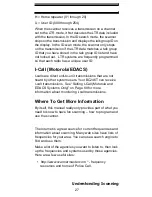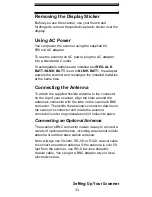
21
Understanding Scanning
Conventional Scanning
Conventional scanning is a relatively simple concept.
Each group of users in a conventional system is assigned
a single frequency (for simplex systems) or two
frequencies (for repeater systems). Any time one of them
transmits, their transmission always goes out on the
same frequency. Up until the late 1980s, this was the
primary way that radio systems operated.
Even today, there are many 2-way radio users who
operate using a conventional system:
• Aircraft
• Amateur radio
• FRS/GMRS users
• Broadcast AM/FM/TV stations
• Many business radio users
When you want to store a conventional system, all you
need to know is the frequencies they operate on.
When you are scanning a conventional system, the
scanner stops very briefly on each channel to see if there
is activity. If there isn’t, the scanner quickly moves to the
next channel. If there is, then the scanner pauses on the
transmission until it is over.
Simplex Operation
Simplex systems use a single frequency for both transmit
and receive. Most radios using this type of operation are
limited to line-of-sight operation. This type of radio is
frequently used at construction job sites, and with
inexpensive consumer radios such as GMRS/FRS radios.
The range is typically 1-8 miles, depending upon the
terrain and many other factors.
452
454
455
462
464
465
466
503
506
516
523
526
532
546
565
606
612
624
627
631
632
654
662
664
703
712
723
731
732
734
743
754
















































